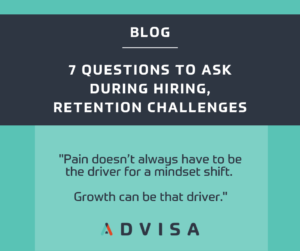7 Questions to Ask During Hiring, Retention Challenges
Data alone won’t solve hiring, retention challenges
Earlier this year, I sat with a group of frustrated managers faced with hiring and retention challenges.
Their firm had started using people data to predict job fit scientifically. At first, the firm’s leaders had created job profiles (every job has a personality, just like people do) that aligned with the people in them to try to fix the roles with the most turnover. Gradually, they also began creating job profiles for the most critical roles in the firm. People data allowed them to get the right people in the right roles for the first time in a while. It was a big step.

They had started hiring well, but they still had a problem: retaining the people they had worked so hard to get. And for this firm, the retention challenges were costing them more than $700,000 every year in lost productivity, decreased client service, sourcing, interviewing, onboarding and training—and repeating this cycle.
Naturally, the retention challenges were hurting all aspects of this company’s business.
Business problems or people problems
All business problems lead back to people problems. And while people data can be a catalyst for individual and organizational change, data alone is not enough. Lead with data, then let that be the springboard that clarifies where you ought to focus. People data is the starting line, not the silver bullet.
While attrition happens for many reasons, Gallup’s State of the American Manager’s report reminds us that “managers account for at least 70% of the variance in employee engagement scores.” Engagement (or lack thereof) is what drives turnover.
Here’s a metaphor for what’s happening in many organizations from “The Book of Awakening,” in which a man was determined to paint his family room:
“Up early, he was out the door, to the hardware store gathering the gallons of red, the wooden mixing sticks, the drop cloths, and the one-time brushes that always harden, no matter what you soak them in. He mixed the paint outside and waddled to the door with a gallon in each hand, the drop cloth under his arm, and a wide brush in his mouth. He began to chuckle in telling what happened: ‘I teetered there for minutes, trying to open the door, not wanting to put anything down. I was so stubborn. I had the door almost open when I lost my grip, stumbled backward, and wound up on the ground, red gallons all over me.’ Amazingly, we all do this, whether with groceries or paint or with the stories we feel determined to share. We do this with our love, with our sense of truth, even with our pain. It’s such a simple thing, but in a moment of ego we refuse to put down what we carry in order to open the door.”
Don’t get stuck
Leaders must recognize that their egos might be keeping them from putting down what “they carry.” Until they do, they won’t be well-served in walking through a new door.
Frustrated that data alone couldn’t keep their people, what my client needed was a moment of introspection. Despite improved hiring, the managers hadn’t been willing to see their ineffective leadership behaviors could be part of the problem. This misstep left them covered in $700,000 worth of red paint.
When we feel stuck, covered in paint, or just plain frustrated, we might need to look within ourselves to question our assumptions, values, beliefs, and truths—to confront our fears and ask, “What if?”
We might need to stop before we go. We might need to be still to have the resolve and energy to push forward.
Pain doesn’t always have to be the driver for a mindset shift. Growth can be that driver.
Questions to contemplate as you consider shifting the mindset in your organization
- What are you holding onto today that holds you back?
- What could you let go of to drive a higher-engagement work culture?
- Which beliefs are no longer serving you?
- Are you leaning on, “We’ve always done it this way.”?
- How are you letting the opinions of others prevent you from opening a new door?
- And who would you be if you put those down?
- How would that affect your ability to achieve the technical changes your strategy requires?
If we don’t take a strategic approach to the management of our people, we can’t take a strategic approach to the technical aspects of the change we seek.
This article originally appeared in the Indianapolis Business Journal on April 26, 2019.
Read More
Most of us would agree that trust is foundational to any relationship. Yet, “building trust” can be elusive – most say they want it but aren’t sure how to get it. If you are looking at developing deeper relationships as part of your strategic people plan, make sure to read “Building Trust – The Elusive Keystone of Engagement.”
